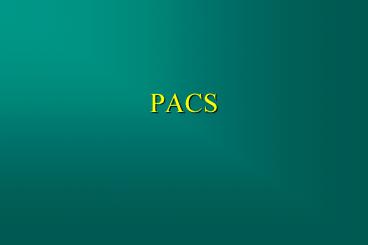PACS - PowerPoint PPT Presentation
Title:
PACS
Description:
What is PACS ? Picture Archiving and Communications System (actually more than name implies) PACS provides the ability to electronically (ie, computer and network ... – PowerPoint PPT presentation
Number of Views:137
Avg rating:3.0/5.0
Title: PACS
1
PACS
2
What is PACS ?
- Picture Archiving and Communications System
(actually more than name implies) - PACS provides the ability to electronically (ie,
computer and network technology) to - Input images from (digital) modalities
- Distribute images to PCs and workstations
- Read on computer display (diagnostic clinical)
- Store (both long and short term) images
- Transmit (to other areas or off-site)
3
Reasons for PACS
- More Efficient Workflow
- RTs spend up to 50 of time handling film
- Reader cannot effectively interpret exams on film
consisting of hundreds of images (eg, MSCT) - Faster Medical Care Delivery
- Images available to reader at exam completion
- Clinical consults possible via remote access
- Potential Cost Savings
- Eliminate lost film
- Improved productivity
- Eliminate lost film preventing lost revenue
4
PACS COMPONENTS
- Network (to acquire/distribute/transmit)
- Servers (to maintain/control database)
- Storage (secondary storage devices)
- Short term (current studies)
- Long term (archives)
- Workstations (reading and clinical review)
- In many cases, specials requirements for PACS
push the limits of technology
5
PACS Basics Size of Studies
- Useful Facts and Terms to Know
- 1 K x 1 K 1 M (eg, 2K x 1.5 K 3 M)
- 1 K x 1 M 1 G (Gig), etc
- Digital images consist of a matrix of pixels
- Each pixel contains a binary number representing
the gray level of the pixel - One or two bytes/pixel
- One (US, NM)
- Two (CT, MR, DR)
6
PACS Basics Size of Studies
- Example 1 4-View Digital Radiography Exam
- 2K x 2.5K matrix 2K x 2.5K 5 MegaPixels (MP)
- 5 MP x 2 bytes/pixel 10 Megabytes (MB)/Image
- 4 images/exam x 10 MB/image 40 MB/Exam
- Example 2 Average CT Exam (300 images)
- 512 x 512 matrix 0.5K x 0.5K 0.25 MegaPixels
- 0.25 MP x 2 bytes/pixel 0.5 Megabytes/image
- 300 images/exam x 0.5 MB/image 150 MB/exam
- Example 3 Large CT Exam (1200 images)
- 0.5 Megabytes/image (same as above)
- 1200 images/exam x 0.5 MB/image 600 MB/exam
7
PACS Components Network
- Communications part of PACS
- Acquire/ distribute/transmit images
- Entirely standards based
- Network Hardware
- Ethernet (most common) using 10- or 100-Base T
- Gigabit (1000Base-T) Fiber channel backbones
- Protocols and Software
- Network protocol TCP/IP (the Internet Standard)
- Image Formats DICOM 3 (this is key)
8
PACS Components Network Issues
- Average CT Exam (150 MB) on 100-Base T
- 100 Base-T maximum 100 Mbits/sec (60 average)
- 150 Mbytes x 8 bits/byte 1200 Mbits
- 1200 Mbits/60 Mbits/second 20 seconds
- Large CT Exam (600 MB) on 100-Base T
- 100 Base-T maximum 100 Mbits/sec (60 average)
- 600 Mbytes x 8 bits/byte 4800 Mbits
- 4800 Mbits/60 Mbits/second 80 seconds
(seems like forever if youre sitting and waiting)
9
PACS COMPONENTS
- Network (to acquire/distribute/transmit)
- Servers maintain/control database (database is
the exam directory patient demographics, what
exams performed and when, where the images are
stored, etc)
- Must maintains database for 5 or more years
- Size and speed requirements depend on facility
- May have multiple servers to share duties
- May have mirrored servers for high availability
10
PACS COMPONENTS
- Network (to acquire/distribute/transmit)
- Servers (to maintain/control database)
- Storage (using secondary storage devices)
- Short term (current studies)
- Long term (archives)
11
PACS Components Storage
- Short Term Storage
- For current studies (and relevant prior studies)
- Need fast retrieval when reader selects exam to
read, server must deliver it within seconds - Most Common RAID
- Typically need 3-4 weeks of short term storage
- Prefer to have 1 year (rapid access to priors)
- Actual amount is cost/performance trade-off
12
PACS Components Storage
- Long Term Storage For archivedstudies
- Speed not as critical (usually exams pre-fetched)
- Must have copies at two sites (JCAHO, HIPAA)
- Need to archive at least 5 years (CT state law)
- Type of archive basically cost/speed tradeoff
- Archive Technologies
- Hard disk based fastest, most expensive
- DVD intermediate speed, moderate cost
- Tape (DLT, LTO, etc) cheap but slow
(reliable??) - Offsite archiving (Service Provider)
13
PACS Storage Issues Data Volume
- Volume of Radiology Data (HH)
- CT 40,000 exams x 150 MB/exam 6 Terabytes
- Radiography 75,000 x 40 MB/exam 3 Terabytes
- All others 1 Terabyte
-
TOTAL 10 TB/years - Archive Requirements
- 5 years x 10 TB/year 50 Terabytes
- Note 50 TB 51,200 Gigabytes !!
- 50 TB 52,428,800 Megabytes !!
14
PACS COMPONENTS
- Network
- Servers
- Storage
- Workstations
- reading/clin view
- usually high end PC
- Diag 2-4 monitors
- Often 3rd monitor (for color/text)
15
PACS Components Workstations
- Diagnostic Workstation (for radiologists)
- Diagnostic Quality Displays (expensive)
- Very High Resolution
- 2K x 1.5K for radiography (1280x1024 max-avg PC)
- 2K x 2.5K common (required for digital mammo)
- Very High Brightness to display graylevels
- 10 bits/pixel (1024 graylevels displayed
- 700 cd/m2 (70-120 for normal CT monitor)































